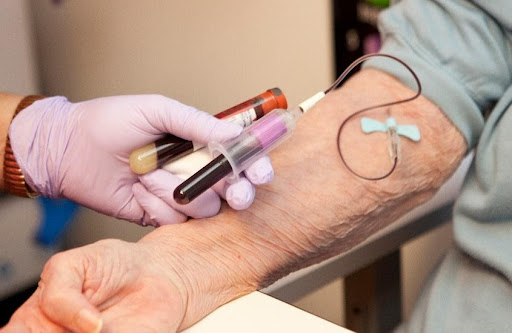Facts About Northeast Medical Institute - New Haven Campus Phlebotomy Course & Cna Class Revealed
Facts About Northeast Medical Institute - New Haven Campus Phlebotomy Course & Cna Class Revealed
Blog Article
The 4-Minute Rule for Northeast Medical Institute - New Haven Campus Phlebotomy Course & Cna Class
Table of ContentsThe Single Strategy To Use For Northeast Medical Institute - New Haven Campus Phlebotomy Course & Cna ClassHow Northeast Medical Institute - New Haven Campus Phlebotomy Course & Cna Class can Save You Time, Stress, and Money.The Of Northeast Medical Institute - New Haven Campus Phlebotomy Course & Cna ClassThe Facts About Northeast Medical Institute - New Haven Campus Phlebotomy Course & Cna Class UncoveredAll About Northeast Medical Institute - New Haven Campus Phlebotomy Course & Cna ClassThe 2-Minute Rule for Northeast Medical Institute - New Haven Campus Phlebotomy Course & Cna Class
The usage of such tools must be gone along with by various other infection avoidance and control methods, and training in their use. Not all security devices are appropriate to phlebotomy. Prior to choosing a safety-engineered tool, customers must completely examine offered tools to establish their proper usage, compatibility with existing phlebotomy practices, and efficiency in shielding staff and clients (12, 33).For setups with low resources, cost is a driving factor in procurement of safety-engineered tools. Where safety-engineered gadgets are not readily available, skilled usage of a needle and syringe is appropriate.
In the blood-sampling area for an outpatient department or facility, supply a comfy reclining couch with an arm remainder.
Northeast Medical Institute - New Haven Campus Phlebotomy Course & Cna Class Fundamentals Explained
Make sure that the signs for blood sampling are clearly defined, either in a written protocol or in recorded instructions (e.g. in a lab kind). In any way times, follow the approaches for infection prevention and control detailed in Table 2.2. Infection prevention and control practices. Accumulate all the devices needed for the treatment and location it within risk-free and very easy reach on a tray or cart, making certain that all the things are plainly visible.
Introduce on your own to the client, and ask the patient to state their full name. Examine that the laboratory kind matches the individual's identification (i.e. match the patient's details with the laboratory type, to make certain exact identification).
Make the person comfortable in a supine setting (preferably). Location a tidy paper or towel under the client's arm. Review the test to be performed (see Annex F) and acquire verbal permission. The person has a right to decline a test at any moment before the blood tasting, so it is vital to make sure that the individual has comprehended the procedure.
Our Northeast Medical Institute - New Haven Campus Phlebotomy Course & Cna Class PDFs
Expand the patient's arm and inspect the antecubital fossa or lower arm. Locate a vein of a great dimension that shows up, straight and clear. The representation in Area 2.3, reveals common settings of the vessels, however numerous variations are possible. The typical cubital blood vessel exists in between muscle mass and is normally one of the most simple to puncture.
DO NOT insert the needle where blood vessels are diverting, due to the fact that this increases the opportunity of a haematoma. The vein must show up without using the tourniquet. Finding the blood vessel will aid in determining the correct size of needle. Use the tourniquet about 45 finger sizes over the venepuncture website and re-examine the vein.
Haemolysis, contamination and visibility of intravenous fluid and medicine can all change the results (39. Nursing staff and physicians might access central venous lines for specimens following methods. However, specimens from central lines carry a danger of contamination or wrong laboratory test outcomes (https://disqus.com/by/disqus_LRlCsjutUE/about/). It serves, however not ideal, to injure specimens when very first introducing an in-dwelling venous gadget, prior to attaching the cannula to the intravenous liquids.
All about Northeast Medical Institute - New Haven Campus Phlebotomy Course & Cna Class
Failing to enable adequate call time boosts the danger of contamination. DO NOT touch the cleaned up site; in particular, DO NOT put a finger over the capillary to direct the shaft of the subjected needle.
Ask the patient to develop a hand so the blood vessels are more prominent. Go into the blood vessel promptly at a 30 degree angle or much less, and remain to present the needle along the vein at the most convenient angle of entry - Phlebotomy blog here Training. As soon as adequate blood has actually been accumulated, release the tourniquet BEFORE withdrawing the needle
Northeast Medical Institute - New Haven Campus Phlebotomy Course & Cna Class Can Be Fun For Anyone
Withdraw the needle carefully and apply gentle pressure to the website with a clean gauze or dry cotton-wool ball. Ask the client to hold the gauze or cotton wool in location, with the arm extended and elevated. Ask the patient NOT to bend the arm, since doing so creates a haematoma.

The smart Trick of Northeast Medical Institute - New Haven Campus Phlebotomy Course & Cna Class That Nobody is Talking About
Do not press the syringe bettor since additional pressure raises the risk of haemolysis. Where possible, maintain televisions in a rack and move the rack towards you. Inject downwards right into the appropriate coloured stopper. DO NOT remove the stopper due to the fact that it will release the vacuum cleaner. If the example tube does not have a rubber stopper, infuse very slowly into television as lessening the pressure and rate utilized to transfer the sampling reduces the risk of haemolysis.

Report this page